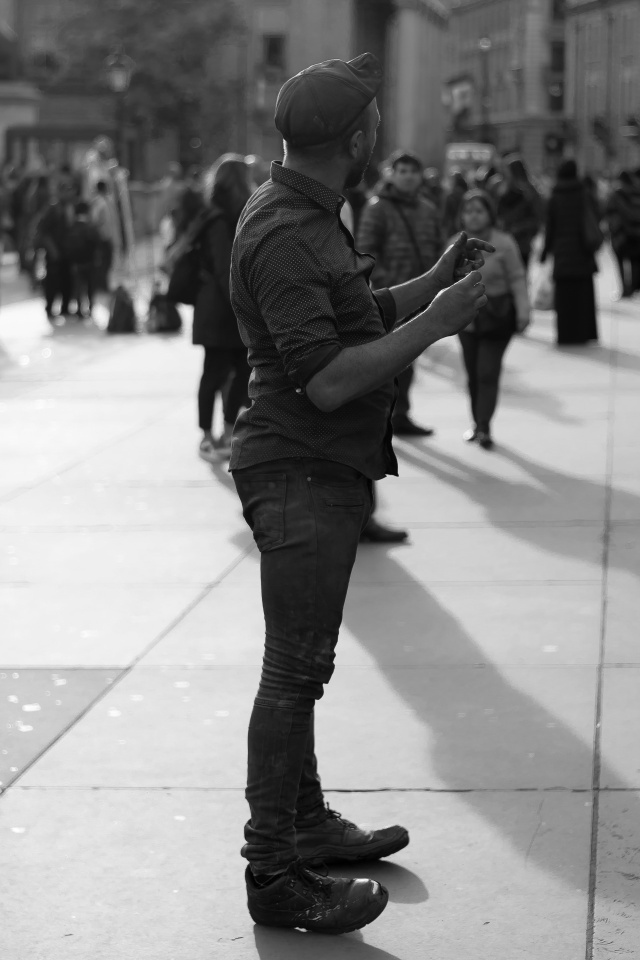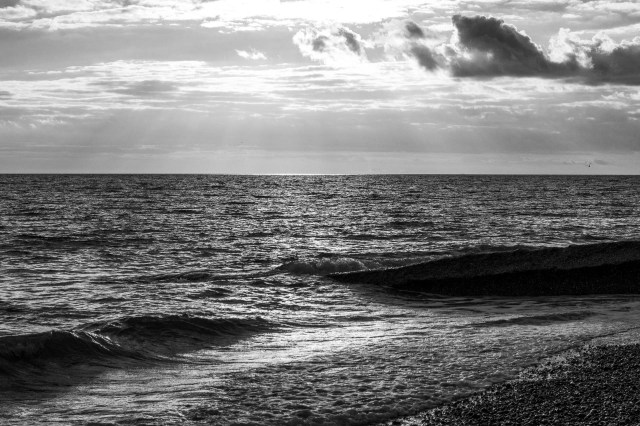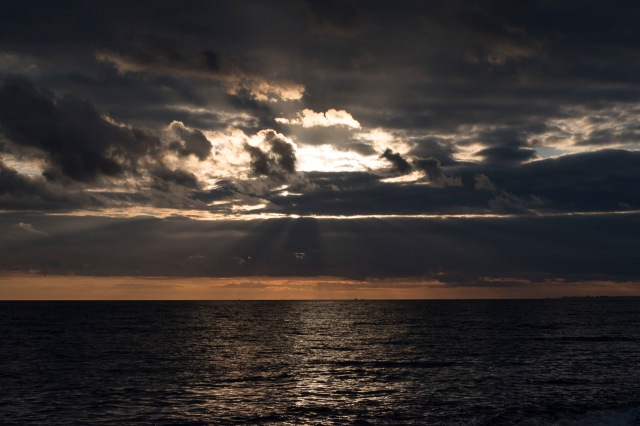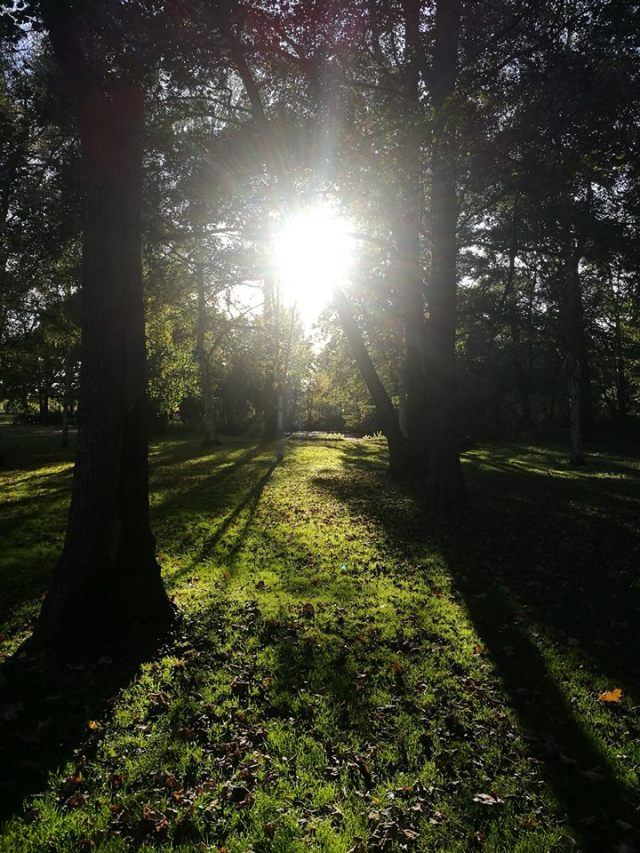On Friday 6th October 2017, the class took a trip to London in order to visit a selection of galleries. These were:
- The Photographers Gallery
- Beetles & Huxley
- White Cube Mason’s Yard
- The Royal Academy of Arts
- Royal Opera Arcade Gallery
The purpose of the visit was to expose us to a range of photography, artworks & galleries then note our observations, conclusions & emotional reactions to the work. We then had to analyse these responses through deconstruction.
Ria had provided a very useful list of pointers to help us ‘pick apart’ and reverse-engineer how, as an individual, I was being affected/or how I was being helped to arrive at my conclusions when viewing a work.
As there were five galleries in total, I’ve split my observations & responses into separate blog posts. While looking through my notes & looking at the photos taken during the day, I realised that it was going to take quite a long time to sift through everything. I will be posting the blog entries with images then add the text as & when I can.
The class met up first at The Photographers Gallery to see Gregory Crewdson’s ‘Cathedral of the Pines’. I’d visited this gallery two times before, so was quite familiar with its layout. The gallery didn’t quite shout that the exhibition was on, but quietly suggested this with the following posters in frame in its café:
The exhibition itself was set over three floors in the gallery. I decided to walk up the stairs. Interestingly, the exhibition ‘started’ on the fifth (& top floor). This meant that you were being directed to the top of the gallery & had to work your way down. I supposed there was a logic to this. Would I notice when viewing the work?
While walking up the stairs, I noticed this on the wall. The gallery uses this space nicely to ‘announce’ the work. I remembered other exhibitions being highlighted in this way.
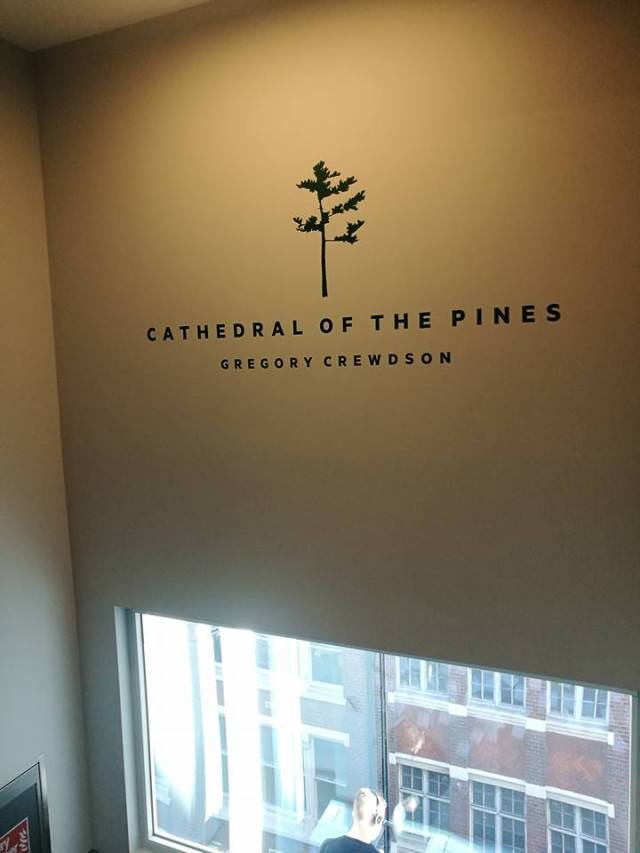
I finally got to the fifth floor, where the following information was there to be read:
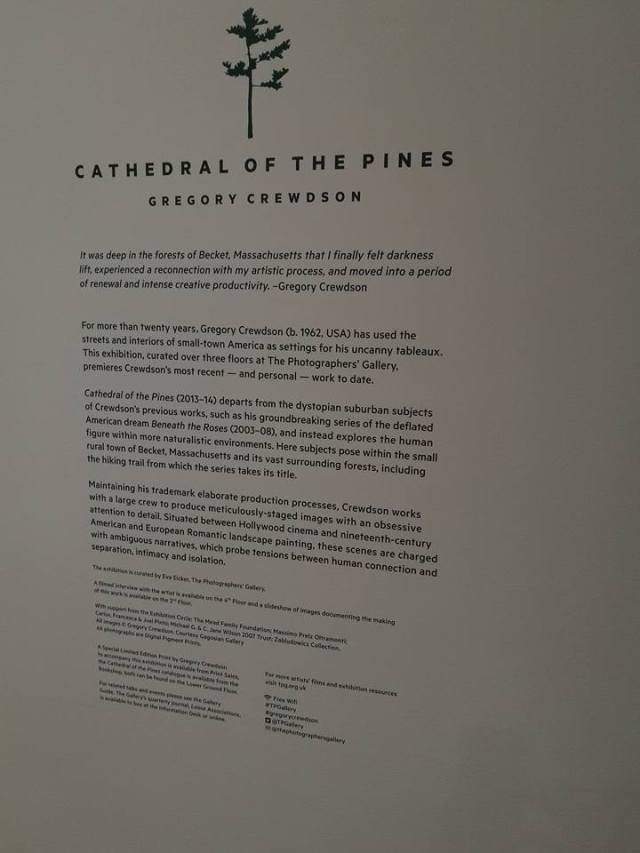
I was slightly aware of Crewdson’s work previously – my classmate Mary has a strong dislike for his work & always gives a ‘shudder’ whenever he’s mentioned. I was reserving judgement until I could see them for myself.
My initial reaction was to take a photo with my mobile phone’s camera of the pieces on display. A literal depiction of what was on display.
I then started to observe the framed prints within the gallery setting & the people viewing them. By doing this, I could reference the print’s size & how they’ve been put on the walls. Looking back, I noticed that these have been hung what appears to be quite low on the wall with a lot of space above. Looks a bit odd, considering the ‘dead’ space above the frame. But when seen with people, they are set at an ideal height for close observation.
I have to admit that by the time I’d gone round the first floor of the exhibition, I wasn’t overly impressed with what I was seeing. The images didn’t ‘grab’ me. I was annoyed with the typical spot lighting & reflective surfaces. The framing was the cliché black square. Disappointed, I walked down the two flights of stairs to the next gallery space.
Again, the same stripped spotlights. The same frames. I then started looking a bit closer. Especially after my classmate, Joanne, made some very pertinent observations about the following image. I also remembered a comment made by Ria about how a photographer can ‘lead’ the observer by manipulating the image in certain ways.
Seated Woman on Bed

My first real observation was the contrast between the seated woman & her surroundings. She was crystal clear. The surrounding image looked like an oil painting – smoother, less defined. Then I noticed all the smaller details. Then it hit me – nothing in this image is ‘accidental’. There was a myriad of messages, some shouting, some whispering. It was up to the observer to make of these as they will.
There was a real sense of loneliness, despite the presence of another person, albeit hidden. Only a hint of toe & outline of a leg under the bedding shows someone there.
Father & Son
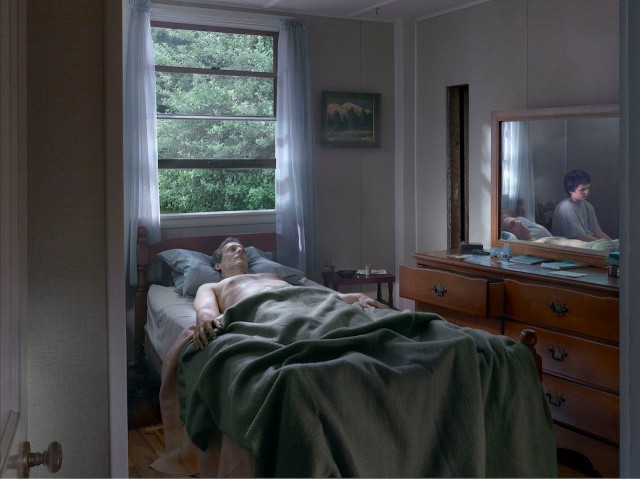
This was one of the most disturbing images in the collection. There was no indication that the man lying in the bed was actually alive. It was as if he’d just died, unnoticed by his (presumed) son. Again, closer observation revealed what was on the bedside chest of drawers & table, including a military badge, a pot of pills, a bible – pages marked with bits of paper, one half of a ‘walky talky’ plus a dog-eared map. All remnants of a lived life.
Woman At Window
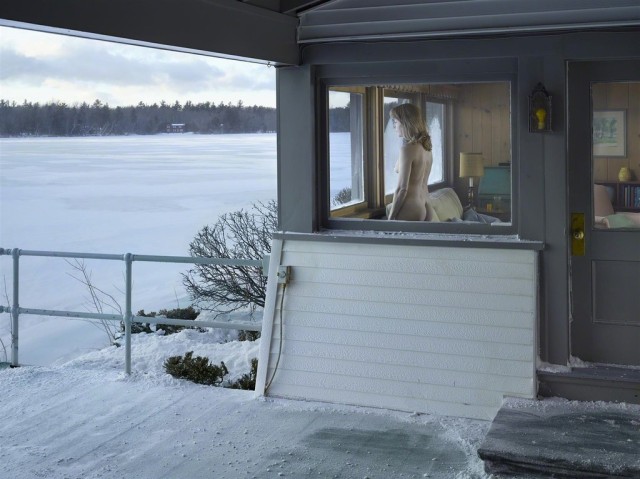
Another image of loneliness – as if the internal setting is as ‘cold’ as the external.
While walking round, I took a look at one of my favourite parts of The Photographers Gallery – the wall where visitors’ comments on the exhibition are posted. Here are few of these:
Got me thinking more about the photos.
Woman in Living Room
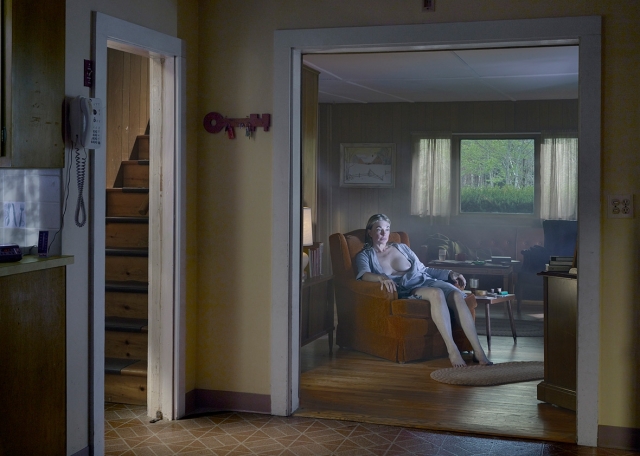
Yet again, another domestic setting of solitude. But instead of looking out onto a landscape, the woman is watching through a different window – the television. One can imagine her looking at images of a world completely different from her own, escaping the drab existence of her day-to-day life. Or she could be watching those less fortunate & thinking ‘glad I’m not in their shoes’.
The Den
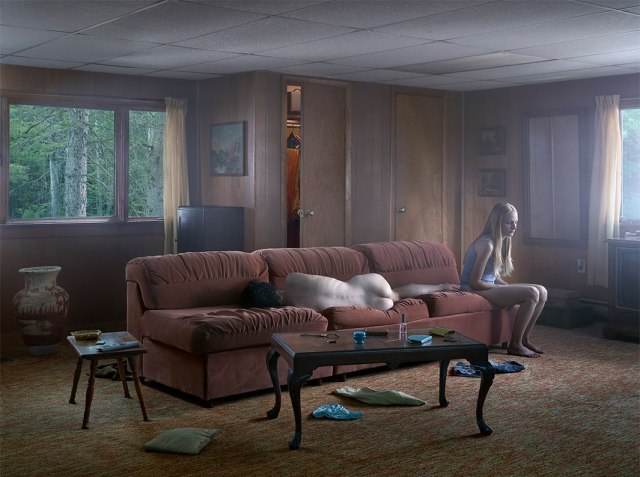
The first thing that strikes when looking at ‘The Den’ is the young woman perched on the sofa. Then my eyes were drawn to the rest of the room. One thing I did notice was the ageing polystyrene ceiling tiles – nicotine-stained & shabby. So glad I wasn’t able to smell the atmosphere in that room. Can imagine it had an ingrained stench of cigarettes, body odour & damp. Also, the figure lying naked on the sofa wasn’t quite obvious at first glance. It suggests a young male lover sleeping off a passionate session while the girl is having regrets of what she’s done.
Woman on Road
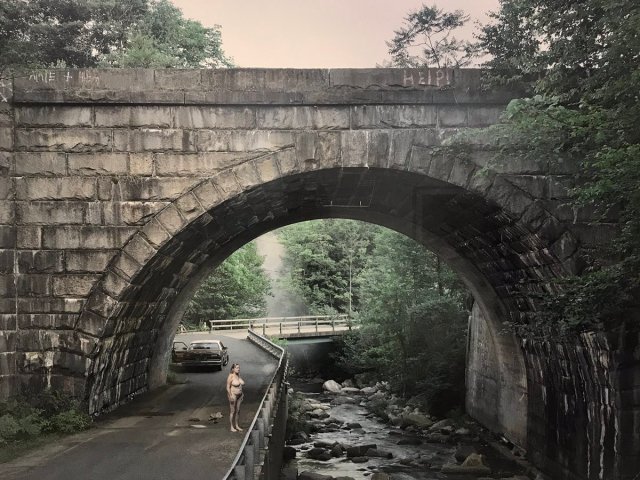
This image was probably the most ‘literal’ of those on display. Almost as if capturing the moments of this woman in the peak of a nervous breakdown. Having driven to a secluded place, got out of the car then discarded her clothes. What is she about to do next? Jump into the shallow river to drown herself? Collapse into a ball of weeping & waling on the road? Or scream, like Sally Bowles in Cabaret, under the bridge? Was she Amie? Did the + person (who’s name can’t quite be read) dump her? Is she crying for “HELP!”? Or did she go back to the car, get a pack of cigarettes discarded on the passenger seat & light up a fag? Who knows…
The Shed
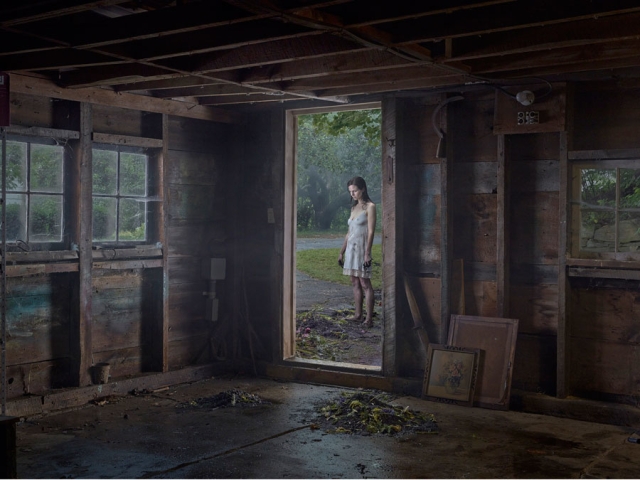
By this time, I was starting the tire of deconstructing the actual images. There was only so much my mind could deal with. However, my observing eye changed its chain of thought. Instead of focusing on the perceived narrative, I started to notice the differences when taking photos of sections of the prints with my Nikon D5500 DSLR. My observation was how these shots exposed the details further than in the print on the wall. It just highlights the amazing nuances of these images.
The Barn

Again, more detailed shots with the DSLR. Again, more observations. What struck me with The Barn is when the close up shot reframes a composition. It turns a slickly constructed porteau view into an intimate portrait.
Telephone Booth
What got me with the following images is not the total, but the details. I was drawn to certain aspects, highlighted by the photos I took.
The Quarry
Interesting. By now my brain had pretty much burnt out. The following is a few more shots taken with the DSLR within the gallery space.
Observers Observed
Criteria Ref: Tasks 1.1 & 1.2



































































































































































































































































